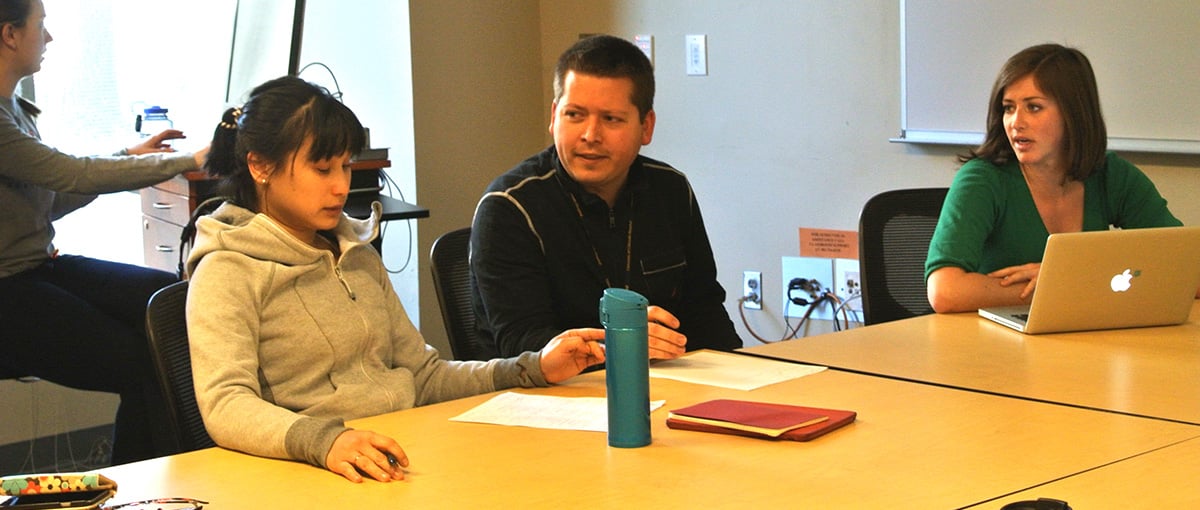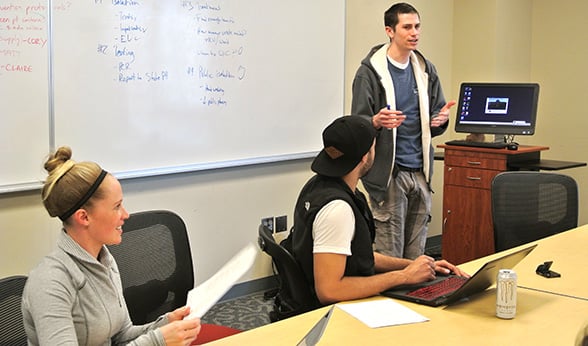A dangerous virus wasn’t the only thing quickly spreading when an outbreak of avian flu swamped the hospitals and clinics of Mountain City and High Plains City.
Tension sometimes flared as public health officials responded to the crisis. Stress often centered around dissemination of accurate information, so as not to touch off undue panic about the pandemic.
It was all part of this week’s preparedness drill on the CU Anschutz Medical Campus – an annual tabletop exercise in the Integrated Clinicians Course for University of Colorado School of Medicine (SOM) students. Two fictional cities in Colorado were dealing with the “outbreak,” and the responders were about 150 fourth-year students representing all disciplines within the SOM. Leading each student team were actual professionals representing health agencies, cities, hospitals, clinics and the media.
‘Critical decisions’
 Students on the Metro News team discuss a story to pursue during the emergency preparedness drill. Tyler Anderson, center, a fourth-year psychiatry student, acted as the team's editor.
Students on the Metro News team discuss a story to pursue during the emergency preparedness drill. Tyler Anderson, center, a fourth-year psychiatry student, acted as the team's editor.
Students went into the exercise knowing only they’d face a health crisis of some kind. “This tabletop is going to cram a pandemic of six to eight weeks … into about 90 minutes,” said Charlie Little, DO, associate professor of Emergency Medicine in the SOM. “There are really no right or wrong answers,” Little told the group before students broke into 16 teams representing health agencies, city and state offices, hospitals and clinics, media and an ethics group. “It’s designed to help you work cooperatively in a group. The key thing is you’re going to have to make critical decisions with limited information, and that’s what happens in emergency management.”
A key part of the exercise was seeing how public health emergency response unfolds and how various agencies coordinate to best manage a crisis, Little said. “The goal is to have the students work through the issues under time pressure like they would in a real-life event,” he said. “That usually gets them a little stressed.”
Metro News, the media outlet in the drill, became a source of irritation for a few agencies and government offices scrambling to contain the pandemic as well as release timely and accurate information.
‘Difficult balance’
Tyler Anderson, a fourth-year psychiatry student, volunteered to be editor of Metro News. He enjoyed the exercise, but found it quite challenging. “It’s kind of a difficult balance” to be both quick and accurate in news reports, he said. “I understood better the reporters’ need for information – like why they push so hard and why it can be annoying to people. But it really helps get information to the public.”
At one point, as Metro News reporters fanned out to press for information, a hospital representative stepped into the “newsroom” and threatened to sue the outlet for an alleged libelous tweet (see video below). Metro News stood by its story.
https://youtu.be/ebaX69RQU48
Anderson said the drill brought to light some comforting insights as well, such as learning about actual strategic medication supplies. “We as medical students aren’t the only ones being trained in what emergency response looks like,” he said. “It’s something that’s being thought about at many levels – city and national government, as well as public health agencies. It’s good to know that it’s being considered and thought about, so something won’t hit us completely off guard.”
Shilo Smith, a fourth-year neurology student, said she has received incident-command training and knows just how quickly things can come unglued in an emergency. “I can tell you it is a challenge to make sure that people have the supplies they need,” she said.
 A public health team discusses how to respond to an avian flu pandemic during the emergency preparedness exercise.
A public health team discusses how to respond to an avian flu pandemic during the emergency preparedness exercise.
Jeffrey Druck, MD, associate professor of Emergency Medicine and director of the Integrated Clinicians Course, spoke to the full group at the exercise debriefing. Students said the fast-paced drill was at times stressful, but also informative as to the enormous coordination required to manage a public health emergency.
“We hope this brings home to you how important it is to get involved in disaster planning early as opposed to later,” Druck said. “As you can see from this exercise, if you are behind the 8-ball it can be much worse than if you are in front of the 8-ball.”